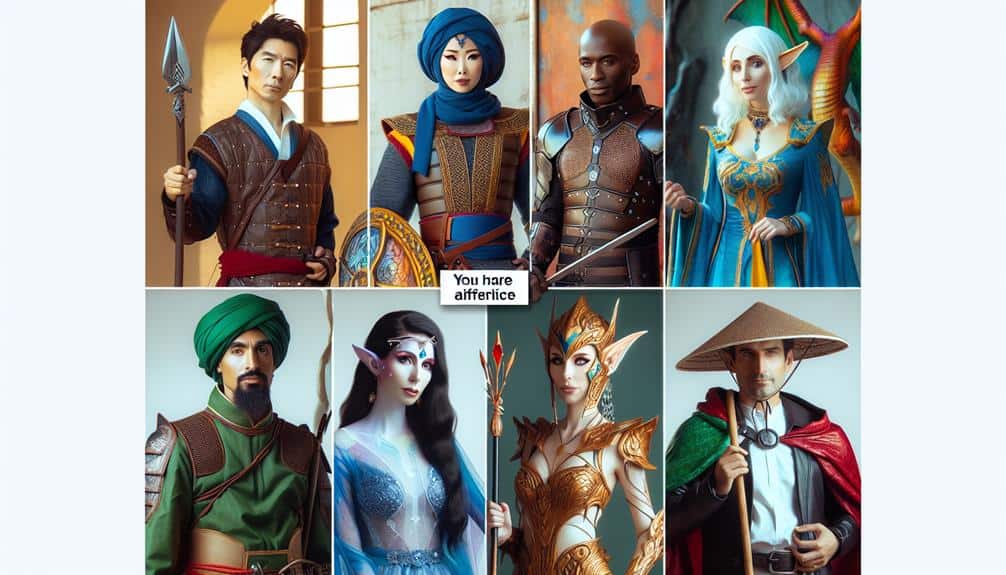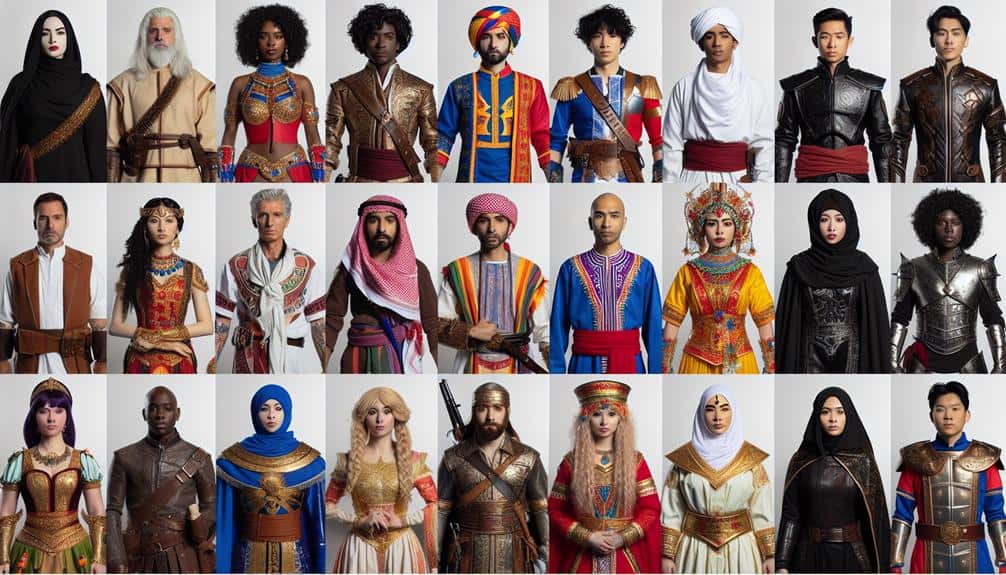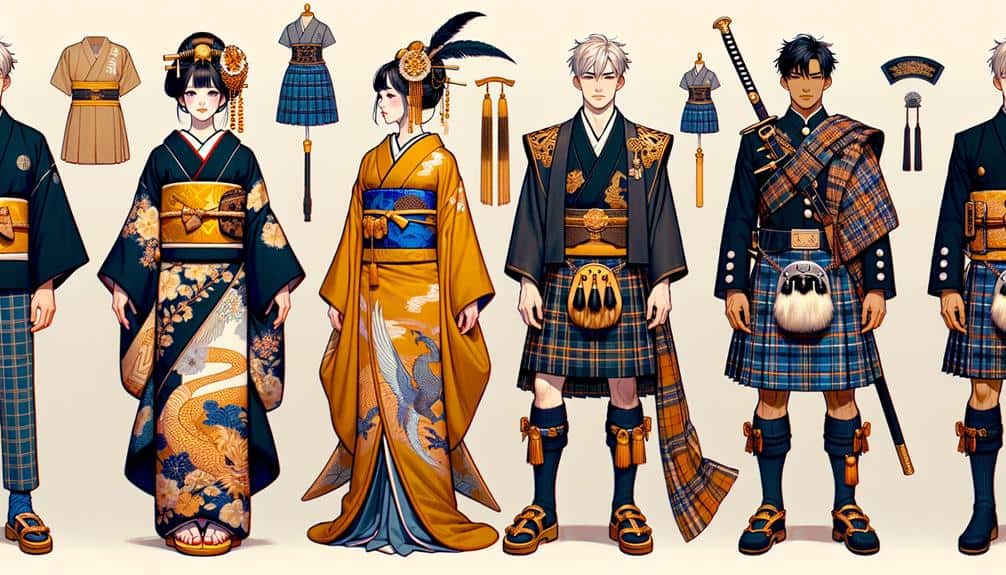When stepping into the world of cosplay, it's pivotal to remember the impact of cultural representation. Imagine embodying characters that resonate with diverse backgrounds and traditions, bringing authenticity and respect to your creations.
But how can you guarantee your cosplay reflects inclusive cultural representation without unintentionally perpetuating stereotypes or disrespecting heritage? By delving into the nuances of cultural significance, attire selection, symbolism, and practices, you'll navigate the domain of cosplay with sensitivity and celebration.
Key Takeaways
- Deeply research cultural significance for authentic representation.
- Ensure attire is historically accurate and respectful.
- Understand symbolism and traditions to avoid misinterpretation.
- Celebrate diversity by showcasing and respecting various cultures.
Researching Cultural Significance
To gain a deep understanding of the cultural significance behind a cosplay representation, immerse into thorough research of its historical and traditional roots. Cultural appropriation and cultural appreciation are essential concepts to contemplate when delving into the world of cosplay. Cultural appropriation refers to the adoption of elements from a marginalized culture by a dominant culture without permission, often leading to misrepresentation or distortion of the original cultural practices. On the other hand, cultural appreciation involves respectfully engaging with and honoring different cultural traditions.
Before choosing a cosplay representation, it's vital to research the historical and traditional background of the culture you aim to portray. Understanding the significance of specific garments, symbols, or practices within that culture is key to avoiding cultural appropriation. By studying the historical context and meaning behind the attire or character you wish to cosplay, you can guarantee that your representation is rooted in cultural appreciation rather than appropriation. Remember, knowledge is power when it comes to accurately and respectfully representing diverse cultures through cosplay.
Choosing Authentic Attire
Consider the historical accuracy and cultural significance of the attire you choose for your cosplay representation to maintain authenticity and respect for the culture you're portraying. When selecting traditional garments, make sure they're accurate representations of the culture you're showcasing. Authentic accessories play a vital role in completing the look; they can include jewelry, headpieces, footwear, or any culturally significant items that complement the attire.
To achieve authenticity, meticulous attention to detail is essential. Research the specific time period and region that the attire belongs to, as styles can vary greatly. Understanding the materials used and the craftsmanship involved in creating traditional garments can also enhance the accuracy of your cosplay representation.
Understanding Symbolism and Traditions
When exploring cultural cosplay representation, understanding the symbolism and traditions embedded in the attire you choose is key to creating a respectful and accurate portrayal. Cultural appropriation is a serious concern when it comes to cosplay, as misinterpreting or misrepresenting symbols can perpetuate harmful stereotypes.
Symbolism plays a critical role in many traditional outfits, representing aspects like status, spirituality, or historical events. To guarantee cultural accuracy, research the significance of each element of the attire you plan to wear. Traditions are deeply rooted in the history and values of a culture, so portraying them correctly is essential for a meaningful representation.
Pay attention to details such as colors, patterns, and accessories, as they often carry specific meanings. By delving into the symbolism and traditions of the culture you're representing, you can create a more authentic and respectful cosplay that honors the heritage and significance of the attire you choose to embody.
Respecting Cultural Practices
Respect cultural practices by thoroughly researching and understanding the customs and beliefs associated with the cosplay you choose to embody. When engaging in cultural cosplay, it's essential to be mindful of the following:
- Guaranteeing Boundaries: Understand the significance of specific symbols, gestures, or attire in the cultural context you're representing. Respect any taboos or sacred elements associated with the cosplay.
- Embracing Diversity: Acknowledge the diversity within the culture you're portraying. Avoid stereotyping or generalizing a culture based on limited knowledge or assumptions.
- Respecting Sacred Practices: Be aware of any rituals, ceremonies, or spiritual practices linked to the cultural cosplay. Refrain from trivializing or misrepresenting these aspects.
- Consulting Cultural Experts: If uncertain about certain cultural practices, seek guidance from individuals who belong to or have in-depth knowledge about the culture. This guarantees accurate representation and shows respect for the traditions you're portraying.
Celebrating Diversity in Cosplay
Diversity in cosplay enriches the community by showcasing a wide range of cultural influences and creative interpretations. It fosters an environment where individuals can appreciate the uniqueness of various cultures through the art of costume portrayal. By celebrating diversity in cosplay, participants can gain a deeper understanding and respect for different traditions, customs, and histories. This appreciation contributes to the inclusivity of the cosplay community, promoting acceptance and understanding among its members.
Costume accuracy plays an essential role in honoring diverse representations in cosplay. Attention to detail in clothing, accessories, and makeup is important to authentically embodying characters from various cultural backgrounds. Researching the historical and cultural significance of garments and symbols is crucial to assuring respectful and accurate portrayals. Incorporating diverse elements into cosplay costumes not only demonstrates a commitment to authenticity but also showcases a dedication to representing different cultures with dignity and respect. Embracing diversity in cosplay allows for a rich tapestry of creativity and representation within the community.
Frequently Asked Questions
How Can Cosplayers Respectfully Engage With Cultural Communities When Researching Cultural Significance for Their Cosplay?
When engaging with cultural communities for cosplay research, respectfully approach members for insight. Prioritize understanding cultural significance and historical context. Actively participate in community events and discussions to gain a thorough perspective.
What Steps Can Cosplayers Take to Ensure They Are Choosing Authentic Attire When Representing a Specific Culture in Their Cosplay?
When choosing authentic attire for your cosplay, confirm respect by researching cultural significance thoroughly. Blend creativity with cultural understanding. Engage respectfully with communities to represent a specific culture accurately in your cosplay.
Are There Any Common Misconceptions About Cultural Symbolism and Traditions That Cosplayers Should Be Aware of When Creating Their Costumes?
When creating costumes, be mindful of cultural appropriation. Research deeply to understand symbolism and traditions to engage respectfully. Avoid perpetuating stereotypes. Guarantee authenticity by consulting with individuals from the culture you wish to represent.
How Can Cosplayers Respectfully Incorporate Cultural Practices Into Their Cosplay Without Appropriating or Misrepresenting Them?
To respectfully incorporate cultural practices into your cosplay without appropriating or misrepresenting them, focus on cultural appreciation, not appropriation. Prioritize cosplay inclusivity and cultural respect by researching, consulting experts, understanding symbolism, and engaging with communities.
In What Ways Can Cosplayers Actively Promote and Celebrate Diversity Within the Cosplay Community?
To actively promote diversity in the cosplay community, you can showcase a variety of characters from different backgrounds, collaborate with cosplayers of diverse identities, attend and support events that celebrate inclusion, and create a welcoming environment for all enthusiasts.



